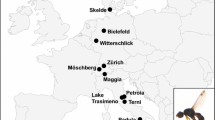Abstract
This study is an in-depth analysis of intersexual, intraspecific, and interspecific variability in larvopupal developmental time, pupation site preference, and larval and pupal survival of a number of isofemale lines of the speciesDrosophila mauritiana, D. melanogaster, D. sechellia, D. simulans, D. teissieri, andD. yakuba. There was no significant sex differences in pupation height, but females eclosed significantly earlier than males in all species. In addition, the suggestion of a strong negative correlation between larval developmental time and pupation height could not be confirmed in this study. The hypothesis that differences in pupation height provide a basis for niche partitioning between closely related species with overlapping distributions was tested by three planned orthogonal contrast analyses of variance. First, the two speciesD. teissieri andD. yakuba, with largely overlapping distribution, were significantly different in pupation height. Second, the two allopatric, nonoverlapping island speciesD. mauritiana andD. sechellia did not significantly differ in pupation height. However, the absence of a significant difference in the final contrast between the two cosmopolitan speciesD. melanogaster andD. simulans, which are often found together, makes us cautious to accept the hypothesis.
Similar content being viewed by others
References
Bakker, K., and Nelissen, F. (1963). On the relations between duration of the larval and pupal period, weight and diurnal rhythm in emergence inDrosophila melanogaster.Entomol. Exp. Appl. 6 37–52.
Bauer, S. J. (1984). Sex difference in pupation site choice inDrosophila melanogaster.Dros. Info. Serv. 60 58.
Bauer, S. J., and Sokolowski, M. B. (1985). A genetic analysis of path length and pupation height in a natural population ofDrosophila melanogaster.Can. J. Genet. Cytol. 27 334–340.
Bauer, S. J., and Sokolowski, M. B. (1988). Autosomal and maternal effects on pupation behavior inDrosophila melanogaster.Behav. Genet. 18 81–97.
Casares, P., and Carrecedo, M. C. (1987). Pupation height inDrosophila: Sex differences and influence of larval developmental time.Behav. Genet. 17 523–535.
David, J., Bocquet, C., and Pla, E. (1976). New results on the genetic characteristics of the Far East race ofDrosophila melanogaster.Genet. Res. Cambr. 28 253–260.
Lachaise, D. (1983). Reproductive allocation in tropical Drosophilidae: Further evidence on the role of breeding-site choice.Am. Nat. 122 133–146.
Lachaise, D., Cariou, M.-L., David, J. R., Lemeunier, F., Tsacas, L., and Ashburner, M. (1988). Historical biogeography of theDrosophila melanogaster species subgroup. In Hecht, M. K., Wallace, B., and Prance, G. T. (eds.),Evolutionary Biology, Vol. 22, Plenum Press, New York.
Legal, L., David, J. R., and Jallon, M.-M. (1992). Toxicity and attraction effects produced byMorinda citrifolia fruits on theDrosophila melanogaster complex of species.Chemoecology 3 125–129.
Markow, T. A. (1979). A survey of intra- and interspecific variation for pupation height inDrosophila.Behav. Genet. 9 209–217.
Rodriguez, L., Sokolowski, M. B., and Shore, J. S. (1992). Habitat selection byDrosophila melanogaster larvae.J. Evol. Biol. 5 61–70.
SAS Institute (1990). SAS/STAT User's Guide: Vol. 2, GLM-VARCOMP, SAS Institute, Cary, NC.
Schnebel, E. M., and Grossfield, J. (1986). The influence of light on pupation height inDrosophila.Behav. Genet. 16 407–415.
Singh, R. S. (1989). Population genetics and evolution of species related toDrosophila melanogaster.Annu. Rev. Genet. 23 425–453.
Sokal, R. R., and Rohlf, F. J. (1981).Biometry, Freeman, New York.
Sokal, R., Ehrlich, P., Hunter, P., and Schlager, G. (1960). Some factors affecting pupation site ofDrosophila.Ann. Entomol. Soc. Am. 53 174–182.
Sokolowski, M. B. (1980). Foraging strategies ofDrosophila melanogaster: A chromosomal analysis.Behav. Genet. 10 291–302.
Sokolowski, M. B. (1985). Genetics and ecology ofDrosophila melanogaster larval foraging and pupation behaviour.J. Insect Physiol. 31 857–864.
Sokolowski, M. B., and Bauer, S. J. (1989). Genetic analysis of pupation distance inDrosophila melanogaster.Heredity 62 177–183.
Sokolowski, M. B., and Hansell, R. (1983). Elucidating the behavioral phenotype ofDrosophila melanogaster larvae: Correlations between larval foraging strategies and pupation height.Behav. Genet. 13 267–280.
Sokolowski, M. B., Bauer, S. J., Wai-Ping, V., Rodriguez, L., Wong, J. L., and Kent, C. (1986). Ecological genetics and behavior ofDrosophila melanogaster larvae in nature.Anim. Behav. 32 403–408.
Winer, B. J. (1971).Statistical Principles in Experimental Design, McGraw-Hill, New York.
Author information
Authors and Affiliations
Rights and permissions
About this article
Cite this article
Welbergen, P., Sokolowski, M.B. Development time and pupation behavior in theDrosophila melanogaster subgroup (Diptera: Drosophilidae). J Insect Behav 7, 263–277 (1994). https://doi.org/10.1007/BF01989734
Accepted:
Issue Date:
DOI: https://doi.org/10.1007/BF01989734




